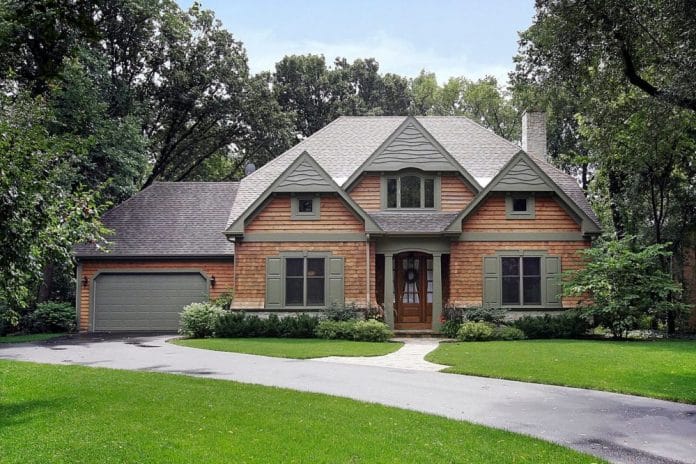Vinyl remains the most popular siding material in the USA mainly to its low price. However, there are other alternatives available on the market: fiber cement, stucco, stone, wood. In this article, you will be able to find pros and cons for each of them and make an objective conclusion if you should consider one of these materials instead of vinyl.
Top Alternatives to Vinyl Siding
Constant demand for vinyl siding should be attributed mostly to the affordable cost of this material and its durability. However, there are other alternatives available on the market, and some of them can be purchased at a fairly competitive price. These are the main shortcomings of vinyl that might convince you to look for alternatives:
- If the vinyl is installed without foam backing, moisture might end up trapped behind the siding. Mold, rot, and mildew will be the consequences you’ll have to deal with.
- Vinyl is sensitive to heat and temperature drops. In cold climates, it quickly gets cracked and fractured. Regular heat makes it warp over the course of time.
- Vinyl can’t be considered eco-friendly. Very few waste collection points accept it, and normally it just ends up in a landfill.
If you are serious about your health, eco-conscious and you want your house to look well-maintained, you might consider the following alternatives to vinyl siding in Delaware.
Fiber Cement
It belongs more or less to the same price category as vinyl but offers a higher return on investment due to its following characteristics:
- long lifespan;
- low maintenance;
- termite resistance;
- fire resistance;
- exceptional durability and the ability to endure winds up to 150 miles per hour.
The weak points of fiber cement go as follows:
- its installation requires special tools and techniques (which add to the cost);
- it needs repaint and repair.
By its appearance fiber cement can easily imitate stucco, masonry, wood and other types of siding materials.
Stucco
Stucco will be the first choice of nearly every siding company from New Jersey, for this material is particularly well designed for hot dry climates. Stucco might come in and out of fashion but it will always be appreciated for:
- outstanding insulation;
- fire resistance;
- termite resistance;
- impressive durability (lasts nearly a lifetime).
However, this siding material has its shortcomings as well:
- it needs regular thorough cleaning and high maintenance;
- it requires a lot of preparation work and it might crack if not installed carefully enough.
Stucco doesn’t necessarily need to be painted: it’s enough to tint it to make it look elegant.
Stone (natural or engineered)
The most appealing characteristics of stone siding are:
- durability;
- easy maintenance;
- weather resistance;
- fire resistance;
- termite resistance;
- premium looks.
At the same time, this material is:
- expensive;
- difficult to install.
While natural stone is a costly material, faux stone and stone veneer are more affordable siding options. However, they don’t look exactly the same, it’s easy to tell the difference.
Natural stone should be used for the houses that were initially built for it. Otherwise, you’ll need to reinforce the foundation. Stone veneer is much lighter since it consists of synthetic materials covered with an outer layer of stone. When updating your home’s exterior, you can safely replace the vinyl siding with stone veneer. Also, engineered stone is an eco-friendly material while its natural counterpart isn’t.
Wood
Among all the mentioned siding materials, natural wood is the most expensive one. Along with the premium looks, it seems attractive to designers and architects for the following reasons:
- it’s eco-friendly;
- with the right maintenance, it can last for decades or even for centuries;
- it never goes out of fashion.
But it must be admitted that wood has remarkable disadvantages as well:
- it is fire-dangerous;
- it needs repainting and restaining every few years (which adds up to its cost);
- to keep away termites, mold, and mildew you’ll have to use sealants.
Engineered wood is a lighter and more affordable alternative to its natural counterpart, but it doesn’t replicate its rich looks precisely.
Conclusion
Among all the varieties of siding materials that are available on the market, vinyl stands out mainly for its low price. Yet when it comes to other advantages, fiber cement, stucco, stone, and wood can easily outperform vinyl:
- Fiber cement is cheap and durable.
- Stucco is a good insulator and lasts nearly a lifetime.
- Stone is weather-resistant and easy to maintain.
- Wood looks premium and is 100% eco-friendly.
The final choice of siding material depends on your esthetic taste, budget and readiness to provide maintenance or not. Mind it that with the most expensive natural materials you can always find a more affordable synthetic option.
ATTENTION READERS
We See The World From All Sides and Want YOU To Be Fully InformedIn fact, intentional disinformation is a disgraceful scourge in media today. So to assuage any possible errant incorrect information posted herein, we strongly encourage you to seek corroboration from other non-VT sources before forming an educated opinion.
About VT - Policies & Disclosures - Comment Policy




